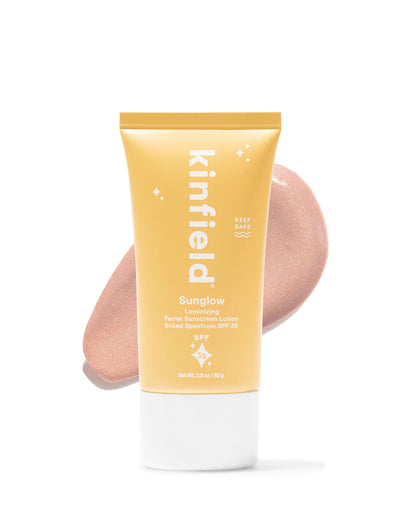Skincare for Kids: What You Need to Know
Remember when skincare use to be something simple? Maybe a quick run through with noxema or makeup remover on the days you wore a little mascara. Some oxyclean for a breakout… not to say any of that was good for the skin, but it certainly was simple. Now kids want a 5 step regimen and they seem to care more about how the bottles look in their bathroom than how the product performs on the skin. When it comes to caring for your child’s skin, you might wonder if skincare is even really necessary at such a young age. The short answer is absolutely, but it doesn’t need to be complicated (and looking good on the counter should be the last thing considered).
Kids' skin is very different from teens and adults', and understanding how it changes from babyhood to the teenage years can help you choose the right products and habits to support healthy skin long-term. Here’s what you need to know.
Skin Development: From Babies to Teens
- Newborns (0-2 years): At birth, a newborn’s skin barrier is immature, meaning it is thinner, more permeable, and prone to trans-epidermal water loss (TEWL). This leaves it vulnerable to irritants, allergens, and environmental factors like humidity and temperature changes. Their delicate skin may show dryness, sensitivity to fragrances or soaps, flaky patches, rashes, or even baby acne. This is all normal! The most important thing at this stage is to use gentle, protective products to keep their skin hydrated and shielded from irritants as it continues to develop.
- Children (3-10 years): As kids grow, their skin gets stronger, but it’s still more sensitive than adult skin. Some children develop conditions like eczema, perioral dermatitis, or cheilitis because their skin barrier and immune system are still maturing. A simple routine is key during these years: a gentle cleanser, a lightweight moisturizer, and sunscreen are all they need. Protecting their skin from the sun and harsh weather is especially important, as children’s skin is more prone to losing moisture and becoming irritated.
- Teens (11-19 years): Puberty brings hormonal changes that can increase oil production, leading to larger pores and acne. Factors like stress, diet, hygiene practices, and sports (which trap sweat and bacteria against the skin) also contribute to breakouts. At this stage, skincare becomes more important, but a gentle and balanced approach is still necessary to avoid disrupting the skin's developing barrier and microbiome.

Current Skincare Trends and Their Impact on Youth
As skincare becomes more commercialized, children and teens are being exposed to a wide variety of products, many containing strong, adult-targeted or overly aggressive ingredients, things like retinols, exfoliating acids, and benzoyl peroxide should NEVER touch a child’s skin. These ingredients were once used primarily by professionals but are now widely available to consumers, and now that unfortunately includes children.
To be clear, the concern is not about toxic chemicals “seeping into the bloodstream,” as the skin is actually an effective barrier against most external substances. The real issue is the overuse and misuse of products that can disrupt the skin’s natural defenses. While young skin is resilient, aggressive treatments may not show immediate harm but can lead to long-term issues like barrier damage, chronic inflammation, and future sensitivity.
What’s more, kids are experimenting with skincare at increasingly younger ages, often without understanding how it impacts their skin’s health. Constantly switching products or using the wrong ones can cause irritation, product dependency, and increase the risk of developing persistent skin conditions like acne, eczema, or rosacea later in life.

Appropriate Skincare for Kids
Skincare for children should be simple and supportive, with an emphasis on protecting their skin’s health and barrier function as well as teaching healthy habits. Just like brushing teeth, teaching kids consistent skincare habits early sets the foundation for lifelong skin health. Here's a basic routine to follow:
- Cleanser: A gentle oil cleanser is an excellent first choice for young skin. Oils rich in linoleic acid (like in Michele Corley Oil Cleanser) balance sebum production and reduce the risk of clogged pores as children begin experiencing oily skin in pre-adolescence. Oil cleansers also preserve moisture and support the skin barrier. Apply to dry skin with clean hands, then remove with a washcloth or in the shower. Unlike foaming cleansers, if some residue is left behind, it won’t cause irritation.
- SPF: Using a broad-spectrum sunscreen is essential from an early age to protect against sun damage, which is cumulative. Opt for lightweight, non-greasy SPFs like Dune Bod Guard or Dune Mug Guard, which are more likely to be used consistently because they don’t feel sticky or uncomfortable. Teaching kids the habit of daily sun protection can help prevent sunburn and reduce the risk of skin cancer and premature aging down the line.
- Moisturizer: A barrier-supportive moisturizer like Hale and Hush Vital Lipid Lotion is great for keeping skin hydrated and preventing issues related to an immature immune response. For acne-prone skin, Corthe First Aid Lotion is a lightweight option that hydrates without clogging pores.
Acne in Youthful Skin
An issue I see arise all too often is parents immediately leaning into aggressive treatments at the first sight of a bump. When the pores develop, we will generally see sebaceous filaments form on the nose and chin. These filaments are completely normal, they just appear more noticeable on skin that was previously pore-less and that is now producing oil for the first time. Yet in these situations, parents are quick to grab highly aggressive products that actually cause more of an issue as the skin begins to learn how to function at this new stage. Foaming cleansers, scrubs, acids, benzoyl peroxide, can all play a role in arresting the skin and telling its brand new developing immune system to stop functioning altogether. This is a recipe for disaster as they hit full blown puberty.
A gentle approach may not yeild the instant gratification of beating the skin into submission, but its sets the foundation for healthy skin to come. It’s important to remember that acne isn’t always the enemy and healthy skin isn’t always clear skin, and clear skin is certainly not always healthy skin.
A basic starting point for teen skin developing acne:
A gentle oil cleanser paired with periodic use of a treatment like Hale and Hush Clear Future Toner (which contains a mild amount of salicylic acid) can help manage mild to moderate acne without causing dryness or irritation.
If acne inflammation worsens, the Missha Time Revolution can soothe the skin and promote healing. Additionally, a gentle mandelic acid serum like Mikura Mandelic Serum can help keep the skin clear while being less irritating than stronger acids.
For more severe and stubborn acne, more advanced intervention could be necessary, but keep it health-centric. You can learn more about acne in our 2 part blog post here:
Part 1 – Acne: What it is and What it Isn't
Part 2 – Acne: How and What to Address
As well as a more in depth article specific to Cystic Acne:
Beyond the Blemish: Understanding and Managing Cystic Acne

Acne Patches and Acne Positivity
One positive trend among teens is the use of acne patches, particularly those made with hydrocolloid, which helps absorb fluid from pimples and speeds up healing. These patches also reduce the urge to pick at breakouts, which can lead to scarring. The fact that teens are wearing brightly colored acne patches openly reflects the growing trend of acne positivity, which encourages acceptance and reduces stigma around acne.
It’s important to look for acne patches that are free of active ingredients like salicylic acid or tea tree oil, as these can sometimes irritate the skin. Hydrocolloid patches alone are effective and gentle enough for regular use.

Safe Additions
Part of the appeal of skincare for people of all ages is that it can be fun, something to do alone as a form of self care or with others and something to share and talk about. It is particularly and even historically a fun activity during sleepovers, so being too strict in this department can certainly backfire - and the goal isn’t to deprive kids of what they want to do, but rather teach them the right way to do it. There are products that can still be used to cover all of these bases and meet needs outside of just simple skincare. After all, we don’t exactly view dental care in that same manner. Masks, mists and creams can all be fun and certain products can still fall into that “simple” guidelines.
The goal of skincare for children and teens should be to protect, educate, and prevent. Teaching kids early about the importance of gentle skincare, sun protection, and maintaining their skin’s natural barrier can set them up for a lifetime of healthy skin. Keep routines simple; a cleanser, moisturizer, and SPF are all they really need. Introduce treatment products slowly and cautiously, always considering their long-term impact on developing skin.
By focusing on these basics, you’ll help your child develop healthy habits that support their skin now and in the future.
Check out our Safe for Children products
as well as our Teen specific products
About the Author:

Dru Pattan is a Licensed Esthetician with a background in cosmetic chemistry, specializing in acne and compromised skin through a barrier first approach. Her philosophy centers on supporting the skin’s natural function rather than forcing it into submission, focusing on long term health over quick fixes.
Her own journey with severe cystic acne sparked her career and remains her most challenging case to date. This personal experience, combined with over a decade in practice, drives her commitment to understanding the science of skin on a deeper level. She has pursued advanced education relentlessly, refining her methods through continual study and practical application.
In addition to her clinical work, Dru is a contributing writer for Dermascope magazine and an advocate for elevating education within the esthetics community. Whether working with clients or mentoring professionals, her goal is to bring clarity, science, and compassion to an industry often clouded by misinformation.




Leave a comment